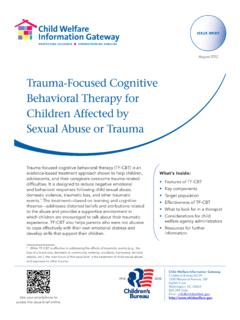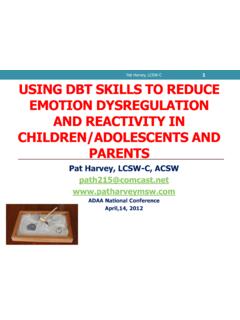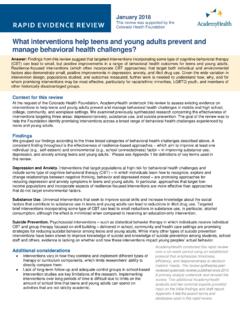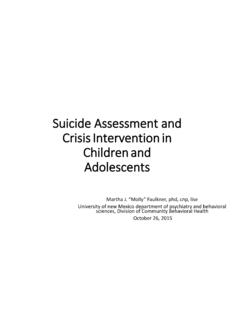Transcription of Treatment Planning for Children and Adolescents Long and ...
1 Treatment Planning for Children and Adolescents Long and Short Term Treatment Goals Prepared by Nancy Lever, and Jennifer Pitchford, LCPC SMHP Program, May 2008 Problem Treatment Goals Academic Issues Long Term Patient will be promoted to the next grade level by end of school year. Patient will be appropriately evaluated and placed in special education if indicated. Patient will attend school 90% of the time (current level _____%). Patient will increase time spent in class learning. Short Term Patient will increase grades from a ____ ( c ) average to a ____ ( , b ) average in all classes (or in specific class).
2 Patient will increase grades from passing 2 out of 4 classes to passing 4 out of 4 classes at next report card/end of year. Family will consent to referral to child study team. Patient will increase the times he/she attends coach classes/tutoring from ____ times per week to ____ times per week. Patient will increase the times he/she turns in homework from ___ times per week to ____ times per week. Teacher reports of student effort will show improvement from current level of _____ to _____ (using academic feedback chart/form). Aggression Long Term Patient will decrease suspensions and expulsions during the academic school year.
3 Patient will decrease the times he/she has a negative encounter with the police. Patient will significantly reduce the intensity and frequency of verbal and physical aggression. Patient will resolve the core issues that are the source of aggression. Patient will improve ability to express anger in a healthy manner. Short Term Patient will reduce frequency of physical fights from ____ to ____ times per week. Patient will decrease office referrals from ____ per month to ____ per month. Patient will increase the time he/she demonstrates skills to walk away from and/or avoid conflict from ____ times per week to ____ times per week (using behavior chart).
4 Patient will increase the times he/she demonstrates positive coping skills from ___ times per week to ____ times per week when frustrated in classroom (using behavior chart). Patient will role-play conflict resolution skills at least one time per session. Patient will role-play how to use words instead of actions in a conflictual situation in session two times per month. Attendance Long Term Patient will attend school 80% of the time (current level _____%). Patient will be on time for school 90% of the time (current level _____%). Patient will not be truant from any classes for the remainder of the school year.
5 Short Term Patient will increase attendance from _____% to _____%. Patient will decrease lateness from ___ days a week to ___ day(s) a week by the end of the semester. Patient will follow an attendance contract to be maintained by _____. Patient will identify reasons behind attendance issues and will problem solve about how to resolve at least one time per session. Patient will increase class attendance from attending ____ classes to ___ classes per week. Patient will attend at least ___ out of ___ therapy appointments per month. Anxiety Patient will identify and resolve issues that are the source of anxiety.
6 Patient will no longer exhibit a particular phobia. Long Term Patient s anxiety will no longer be at a clinical level and will demonstrate improved functioning. Patient will show a reduction of anxiety on the _____ scale from current level of _____ to _____ by the end of the school year. Short Term Patient will verbally identify fears, concerns, and anxiety at least one time per session. Patient will show a decrease in anxiety from ___ to ___ on an anxiety measure over school year. Patient will demonstrate positive self-talk at least one time per session. Patient will increase engagement in relaxation techniques from ___ times to ___ times per week (recorded on chart/in journal).
7 Patient will be able to identify precipitants/triggers to anxiety one time per session. Patient will use thought-stopping techniques one time per week (recorded on chart/in journal). Body Image Long Term Patient will eat in a healthy manner and will have a realistic view of his or her body size. Patient will not engage in any binges or purging. Patient will be able to gain insight into issues behind his or her disorted body image. Patient will improve self esteem and become more forgiving and accepting of his or her body. Short Term Patient will identify two positive physical attributes at least one time per session.
8 Patient will discuss eating habits and healthy eating at least one time per session. Patient will express thoughts/feelings related to body image at least one time per session. Depression Long Term Patient will decrease depressive symptoms. Patient will not exhibit any suicidal actions or gestures. Patient s depression will no longer be at a clinical level and he or she will demonstrate improved functioning. Patient will identify and gain insight into sources contributing to the depression and will demonstrate improved mood . Short Term Patients CDI scores will decrease from baseline of ___ to ___.
9 Patient will be able to identify negative self-talk at least one time per session. Patient will be able to report that he or she was able to verbalize sadness to family or peer at least one time per week (record in journal). Patient will increase number of positive self-statements/affirmations in session from current level of _____ to _____. Increase involvement in activities with peers from ___ times to ___ times per week. Disruptive Classroom Behavior Long Term Patient will decrease disruptive behavior in the classroom. Patient will follow teacher directions in the classroom.
10 Short Term Patient will increase the times he/she is in seat when expected to be (tracked on behavior chart 3 warnings per day). Patient will say at least 1 nice thing to a classmate per day in the classroom (tracked on behavior chart). Patient will raise hand appropriately at least one time per day in class (tracked on behavior chart). Patient will have appropriate materials on desk at least 2 times during the school day (tracked on behavior chart). Patient will remain quiet unless otherwise directed with two reminder per class. Clinician will observe student in classroom setting and see a decrease in _____from _____to _____.






